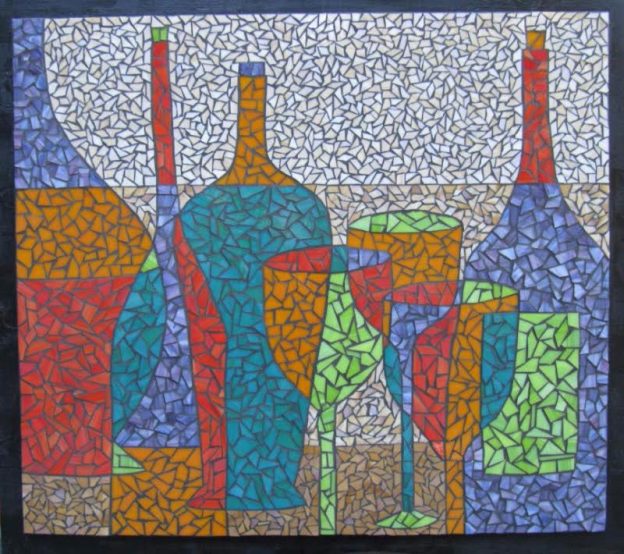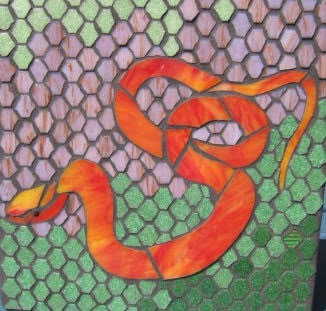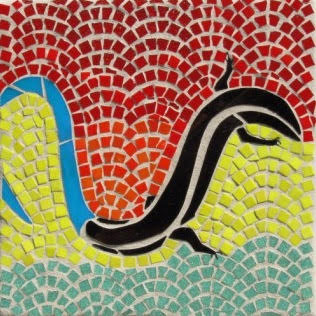Pricing art is difficult because it is subjective, and pricing mosaic artwork is even more problematic due to the extra labor required to make it, but there is a structured way to determine a hard number, even if the buyer is a friend or relative.
Recently artist Valri Castleman emailed my a photo of her untitled mosaic shown above and asked for my advice on how to price it for a family member. Normally I am not drawn to mosaics made from triangular pieces, but I like Valri’s mosaic and think it is worth sharing for several reason. For starters, there is some sophisticated “figure-ground-reversal” going on that reminds me of Picasso and the Cubists. There is also some interesting use of grout lines to outline figures. Lastly, the mosaic is a good case study for how to price your art for sale to a friend.
I have pictures of some of Valri’s other work throughout this article. Notice how each piece is an experiment in some new direction instead of a simple variation of what she has already figured out. Even in the two variations on reptiles and scales, there is something new attempted in each. That speaks to me.
Objective Factors
The first place to start in pricing anything (art or otherwise) is to determine your costs, specifically labor and materials.
Even if you decide to give the piece away for a song, it’s good to know what the art cost before you make that decision.
Materials
Valri’s mosaic is 29 inches x 33 inches, which is 957 square inches or 6.6 square feet.
For stained glass, glue, and grout, I estimate $25/sq ft, which gives $166 in mosaic materials, plus a backer and mounting system, and so $200 in materials total.
Labor
Valri didn’t track the hours she worked on this project, which happens often even for professional artists because it’s all about losing yourself not punching a clock, but we can set a low estimate for what it took to make this mosaic, say 30 hours. At $15 per hour, which is probably much lower than what either Valri or her buyer consider a decent pay rate for skilled labor, we have $450 as a low estimate of labor cost.
So, if Valri charges $650 for this mosaic, she is barely covering time and materials.
Expertise
A price of $650 doesn’t take into account the fact that the mosaic is original artwork or what experience and practice Valri needed to conceive of the design and execute it. If the buyer is a member of the general public (meaning not a friend or relative), a good rule of thumb is to double the cost of labor and materials to account for the expertise required to make the art. Of course, the expertise factor can be higher if you are working as an artist and having regular shows in galleries, but now we are getting into subjective factors.
Subjective Factors
If your buyer is a friend or relative, these factors tend to decrease the asking price instead of increasing it.
Avoid Sticker Shock
A good way to prevent “sticker shock” is to educate your buyer about the time required to make a mosaic. Show them how you cut the glass. Show them your work table or studio. They will likely be as interested in the process as much as the finished product, and it will help them appreciate what it took in terms of time and materials to create the mosaic.
The Buyer’s Background
Is your relative worldly and educated? Do they collect art? What is their general income level? Do they own a home renovation company, or do they work as an hourly carpenter’s assistant for that company?
If your friend or relative is like most ordinary people in middle America, chances are they have very little experience with buying original art and think only in terms of prices for mass-produced goods. There may be a ceiling on what you can ask this particular person for the art without seeming unrealistic or seeming like you are taking advantage of your relationship with them.
Just because a relative has asked to buy a piece of your artwork doesn’t mean that you have to sell them anything. Rather than charge a price that doesn’t cover the cost of producing the mosaic, or get into an awkward situation, you might decide to simply make a gift of it.
All that being said, if your relative is educated and well-traveled and all that, you have a solid basis for charging them full price, especially if you make art for a living or aspire to do so.
If you are uncertain whether your friend or relative has an appreciation of what art costs, then make sure you show them your work space and what was required to create the art.
Your Relationship With The Buyer
Is your buyer the grandmother who raised you after your mother passed away, or is this a second cousin or a friend who is more of an acquaintance? If the situation is more of a gift than a sale, then make it a gift. That being said, if a friend or relative is trying to make you a gift of money, then let it happen.
Your Professional Aspirations
If you are wanting to make art professionally, then you need to get into the practice of charging what it is worth and not undercutting the galleries that sell your work.






Leave a Reply